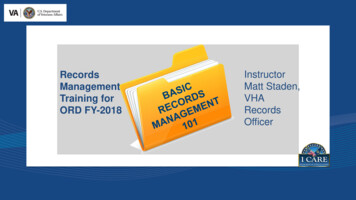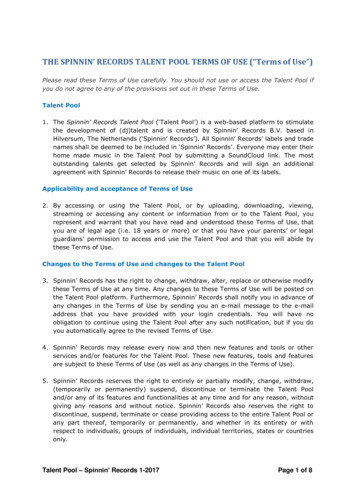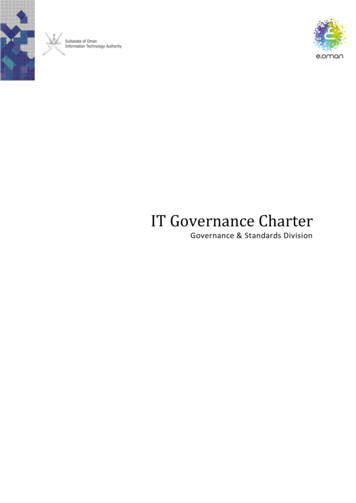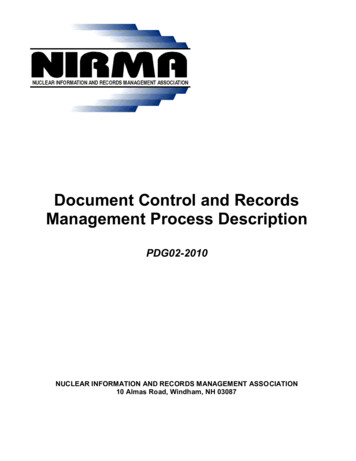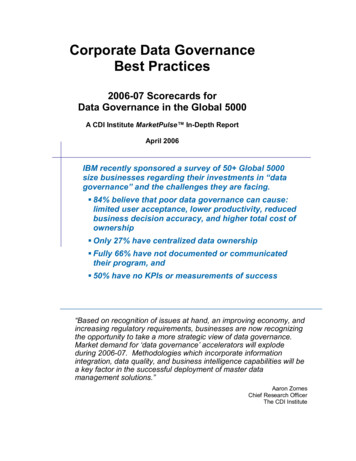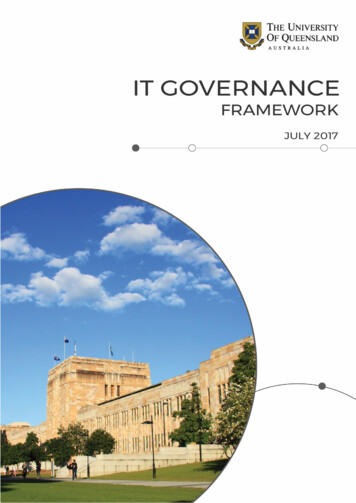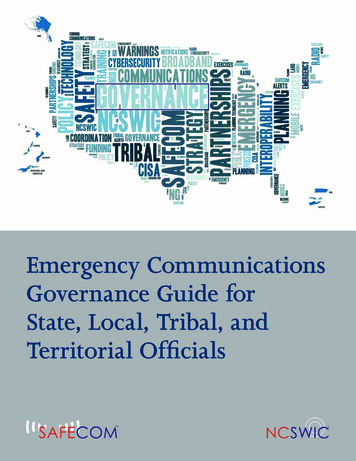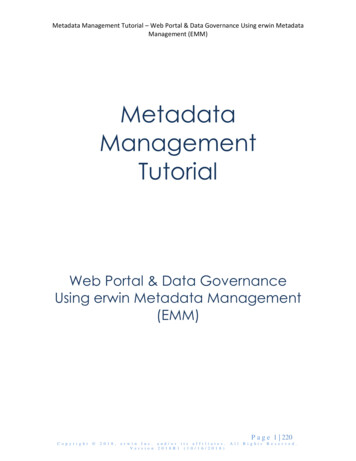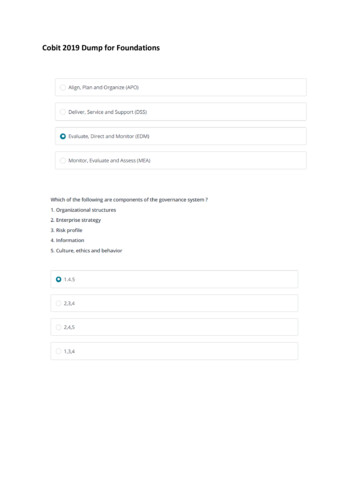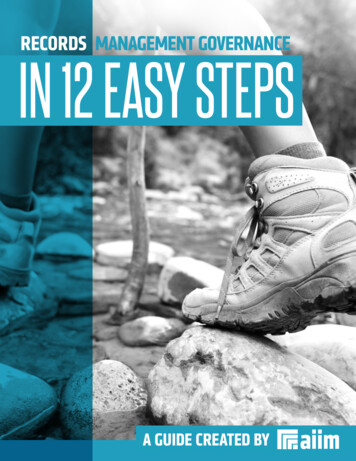
Transcription
RECORDS MANAGEMENT GOVERNANCEIN 12 EASY STEPSA GUIDE CREATED BY
RECORDS MANAGEMENT GOVERNANCEIN 12 EASY STEPSRECORDS MANAGEMENTGOVERNANCEIN 12 EASY STEPSNot too long ago, records management was a primary concern for many organizations. A small event in a largeorganization was the trigger that catapulted records management to a topic that was being discussed in board roomseverywhere and resulted in numerous regulations being drafted and adopted.Once the visibility of the initial situation calmed down, records management was quickly returned to its normal placeof perceived importance and organizations quit talking about it. While we have not seen any organizations or companyexecutives being fined or sent to prison for their organization’s records management transgressions, that is not causeto let our guard down.This guide was developed to help you and your organization in your records management endeavors. We have strivedto identify the key areas that should be reviewed to help you avoid unfortunate and costly non-compliance issues withyour records. aiim.org02
RECORDS MANAGEMENT GOVERNANCEIN 12 EASY STEPSGETTING GOVERNANCE RIGHTRecords Management Governance is key to any good records management program. There are threeelements to Records Management Governance:Records Management PolicyRecords Management PlanRecords Management ProgramThe foundation of any records management strategy and/or program is the Records Management Policy which:Distinguishes records management as a key part of the organization strategySets expectations for the way employees participate in the normal course of businessIdentifies and establishes the responsible authority for records, content and information in the organizationThe Records Management Plan:Defines the rules for creating and capturing records and metadataProvides guidance for how records are received from other organizational or outside entitiesProvides guidelines for transferring records to other organization units or outside entitiesDefines the maintenance of records and associated metadata, disposition (destruction or archival)activities and appropriate documentation of those activities, and third-party (contractor, subcontractor)requirementsIdentifies all relevant national standards and legal, regulatory, or contractual documents that must befollowed for complianceProvides for management structures, record inventorying, retention schedules, a corporate filing plan,vital records protection including backup/disaster recovery, records center operations and InformationTechnology (IT) department obligations, preservation, and records management training, monitoring,and auditing aiim.org03
RECORDS MANAGEMENT GOVERNANCEIN 12 EASY STEPSThe Records Management Program includes guidance on record status of working papers or files and drafts, personalpapers, use and removal of documentary and record materials, mapping of business activities to various records’lifecycle and provides guidance and instructions for documenting policies and decisions, especially those decisionsreached orally and for those communicated electronically.Have you established a Records Management Policy?Does it identify Records Management as a key organization strategy?Does it set expectations? Does it identify the authority responsible for recordsmanagement?Did you develop a Records Management Plan?Does it provide rules for creating and capturing records?Does it provide guidance on the maintenance of records and their associatedmetadata?Does it provide guidance for management structures, record inventorying,and scheduling?Have you established a Records Management Program?Does it provide guidance concerning personal papers and working drafts?Does it help map business activities to records lifecycle? aiim.org04
RECORDS MANAGEMENT GOVERNANCEIN 12 EASY STEPSSTEP 01KNOW WHAT YOU HAVEThe records inventory identifies and quantifies ALL organizational records—paper and electronic. Once the recordsare identified, they are then analyzed for various purposes:Records retentionLegal protectionImprovement opportunitiesIn electronic environments, the inventory is also important because each records series must be addressed by specificrules that must be programmed into your Records Management Application (RMA).Tracking the records will be made easier if you use or modify industry-standard templates or use a RecordsManagement tool that may be a part of your RMA.Key Questions:Have you conducted a records inventory to identify all organizational records inboth paper and electronic format?Does it identify all the records (paper and electronic)?STEP 02KNOW WHAT TO DO WITH WHAT YOU HAVEOnce you have identified and analyzed your records, you can take that information to develop a timetable thatwill determine how long your records must be kept and when they can be disposed. The timetable should includereferences to statutes and other legal issues associated records series as they relate to your specific industry. It isalso a good idea to take into consideration good business practice and document the treatment of records not onlybased on statutes and regulations but also good business practice. The Records Retention Schedule should enablean evaluation of records for various purposes:Administrative including control and review (i.e., external audit), fiscal, and tax purposesLegal which may be compliance-based and include statutes of limitation considerationsInformational, i.e., research value, are typically determined by business units themselvesKey Questions:Have you developed your Records Retention Schedules?Did you include a timetable for how long records must be kept?Did you consult statutes and regulations at the Federal, State, and local level? aiim.org05
RECORDS MANAGEMENT GOVERNANCEIN 12 EASY STEPSSTEP 03ESTABLISH A FILE PLANThe file plan documents the indexing and classification schemes for arranging, storing, and retrieving records.It is usually organized by records series or category. Each records series includes a description, record keepingrequirements, roles, disposition, and associated non-record collections.Key Questions:Have you established a File Plan detailing your indexing and classificationschemes?Did you include descriptions of the records and any record keeping requirementsthat you want to have followed?STEP 04ENSURE REGULATORY AND LEGAL COMPLIANCETo ensure regulatory and legal compliance at the federal, state/province, and local municipality levels, your recordsmanagement program should identify relevant laws, best practices, and tests as well as testing metrics to ensure theintegrity of your records.Key Questions:Have you identified the standards, laws, best practices, and test/metrics thatyou need to follow?Did you investigate the laws and regulations at the Federal, State, and locallevels?Did you establish quality metrics for your records? aiim.org06
RECORDS MANAGEMENT GOVERNANCEIN 12 EASY STEPSSTEP 05ENSURE BUSINESS CONTINUITYWe never know when a disaster, large or small, may happen so it is important to do your planning before you findyourself in a disaster situation. Continuity planning, continuous data protection, and disaster recovery are part ofa risk management strategy. Business continuity planning directly determines how an organization protects andbacks up its records, metadata, and other information, including frequency and establishment of hot, warm, and/or cold sites.Backup and Disaster Recovery plans are somewhat subjective. Rarely will an organization fail a records managementaudit because of how these plans are produced. However, not having a plan for records recovery may put passing athird-party audit at risk.The Backup and Disaster Recovery plans should be reviewed on a regular basis and modifications made to keep theplan current to the organization’s needs and information architecture.The key to continuity is ensuring the records necessary to run the business are available. A Vital Records Programidentifies and protects those records that are necessary for the continuation of operations under emergencyconditions. The policy and procedure for these special records must be documented for on and off-site storage aswell as backup and disaster recovery for electronic records.Key Questions:Have you established a Vital Records program?Did you identify the records considered to be vital to the continuity of yourbusiness?Have you developed/reviewed your Backup/Disaster Recovery Plan?Did you test your Backup/Disaster Recovery Plan to make sure it works and thatnothing has been neglected? aiim.org07
RECORDS MANAGEMENT GOVERNANCEIN 12 EASY STEPSSTEP 06PROTECT YOUR INFORMATIONPolicies, procedures, and processes must be developed to ensure protection of all confidential information(requirements will vary depending on record type) when stored, accessed, and transferred. Companies mustinvestigate their record systems and communications to ensure proper:Treatment of security designationsInternal and external access privilegesLabeling of documents and communicationsTracking of record creation, access, modifications, deletion, and transfersIdentification of records under hold ordersOrganizations must have a written and communicated policy concerning email, instant messages, and social networkcommunications. If used, all formats must be addressed in the Records Management Plan. One common way tofail an audit is by not having policies that do not preclude corporate email from being forwarded to personal emailaccounts. Co-mingling of corporate and personal information is wrong and can have significant implications shouldyour organization get into a legal situation.Key Questions:Have you developed/reviewed your Security and Privacy Plan?Did you include email and social network communications in your plan?STEP 07MAKE IT EASY TO FIND STUFFMetadata management involves information pertaining to records but ancillary to the records themselves.Metadata can:Serve as retrieval aidsHelp you track recordsAssist with monitoring usage, actions, and location (in the case of physical records)Metadata can also provide metrics on business process performance. In the case of Enterprise Content Management(ECM) or other electronic systems that store records, metadata can also be used instead of legacy applications tostore information. In those cases, the ECM system then becomes a line-of-business of application that processes andhandles more than just the records themselves.Key Questions:Have you developed/reviewed your taxonomy and metadata schema?Does your schema take into consideration commonly used terms? aiim.org08
RECORDS MANAGEMENT GOVERNANCEIN 12 EASY STEPSSTEP 08MANAGE IT ALLRecords Center considerations include managing volume, granularity of accessibility, security provisions at eachlocation, employee screening, transport methods, request and transfer procedures, temperature and humiditycontrol, fire suppression, risks posed by toxic or hazardous materials, and records movement tracking. IT departmentsgenerally understand requirements for hot, cold, and warm sites, and protection of electronic information.Key Questions:Have you developed/reviewed your Records Center Operations Procedures?Do your procedures establish security provisions for the workers and transportingyour records?Did you identify the temperature and humidity controls needed to preserveyour records?STEP 09MAKE SURE YOUR RECORDS STAY AROUNDPaper can disintegrate, ink can fade, bits and file formats can be lost, and microfilm can undergo chemicaldecomposition. For most analog storage (paper, film) preservation is a function of storage conditions and handling.For digital storage, media life and file format must be carefully considered.We can easily understand what to do to preserve physical records. The increased volume of digital documentsis presenting a new issue for organizations. It is important to carefully investigate the file formats to make surethe one you choose to preserve your digital documents is sustainable, developed by authoritative independentorganizations, and not reliant on technology. There is no one perfect file format and new ones are being developedall the time. Therefore, it is important to make sure the format you choose will allow you to migrate to a new formatif you choose to do so.Key Questions:Have you developed/reviewed an information preservation plan for physicaland digital information?Do you identify a file format use when preserving your electronic records?Do you define a migration plan in the event you need to migrate your recordsto a new format or storage medium? aiim.org09
RECORDS MANAGEMENT GOVERNANCEIN 12 EASY STEPSSTEP 10GET RID OF RECORDS BEFORE IT IS TOO LATEThe process of distribution involves the destruction or archival of records that no longer must be maintained becausetheir retention period has lapsed, either immediately (best for risk management) or at regularly scheduled intervals.A disposition policy must address records retained past the retention period due to their business value, and includedocumentation procedures for recording the rationale behind additional retention.If archived (whether internally or outsourced), organizations must establish that all operational and administrativeneeds have been satisfied prior to transfer, and appropriately document records to be transferred. Whether destroyingor archiving records, organizations must determine the extent to which it is necessary to retain record metadata.The disposition procedure for a record series involves documenting the steps involved and maintaining thedocumentation as records. You should include in your documentation the following information:Assign authorityVerify retention requirementsSuspend destructionDocument destruction detailsUpdate the RM systemDestroy copiesMeet confidentiality, security, and privacy requirementsKey Questions:Have you reviewed your disposition/destruction/archival proceduresand audited the implementation of the procedures?Did you assign authority for your records program?Have you verified your retention requirements? aiim.org10
RECORDS MANAGEMENT GOVERNANCEIN 12 EASY STEPSSTEP 11TRAIN THE TEAMEstablish a training program that covers ALL aspects of the RM program (including management, employees,contractors, etc.) regarding the role that information and records play in serving the organization.Document and provide the training regularly. Documentation includes training materials, information about thetrainer, attendees, and date and time of attendance.Combine on-the-job training and formal education. Benefits include reduction in costs and risks due to moreefficiencies, standards compliance, and error reduction.Key Questions:Have you established a training program?Does the training cover all aspects of records management at all levels ofmanagement in your organization?Do you regularly offer the training?Is your records management training provided to employees entering yourorganization?Do you provide regular refresher training for all employees?Do you require ALL employees to renew their training?STEP 12MONITOR, AUDIT, AND OPTIMIZEOrganizations must preserve records concerning annual internal monitoring and external auditing activities of therecords management program. Whether required by regulatory agencies or as part of a corporate risk managementinitiative, external auditors will want to review internal monitoring efforts to establish sufficiency, validate completeness,and, possibly, recommend opportunities for improvements and potential efficiencies. Internal monitoring activitiesshould dovetail with corporate training. External auditors will want to review previous audit documentation, findings(including deficiencies noted), and corporate efforts to correct deficiencies.Key Questions:Have you scheduled and implemented periodic audits to identify your risks?Do you look for areas in your program that you can improve?Do you look not only at the way records are handled but at the processes todetermine how they can be improved? aiim.org11
RECORDS MANAGEMENT GOVERNANCEIN 12 EASY STEPSCONCLUSIONABOUT AIIMRecords are an asset that organizations must manage.Records management establishes the practices andguidelines that must be followed to ensure that any recordcreated or used in an organization in the course of normalbusiness activities is maintained properly. As a result of theintroduction of the regulations, organizations are moreaware of their records and are regarding them as businessassets rather than taking them for granted. Now, what weneed to do is manage the records more effectively.Here at AIIM, we believe that informationis your most important asset and we wantto teach you the skills to manage it. We’vefelt this way since 1943, back when thiscommunity was founded.Don’t rush your records inventory. It will help you to planyour storage requirements for onsite and archival needs.Make sure that you involve your legal department along withyour records managers, IT department, and line-of-businesssubject experts to ensure all factors are thoroughly exploredas you analyze your records and develop your RecordsRetention Schedules. When the analysis is completed, itshould be reviewed by your organization’s leadership andapproved at a high level in the organization.Sure, the technology has come a long waysince then and the variety of informationwe’re managing has changed a lot, butone tenet has remained constant. We’vealways focused on the intersection ofpeople, processes, and information. Wehelp organizations put information towork.AIIM is a non-profit organizationthat provides independent research,training, and certification for informationprofessionals. Visit us at www.aiim.org.While it is best to use standards, best practices, and test/metrics that have been vetted through a rigorous process,you should also identify and document those standards,best practices, and test/metrics that you have developedwithin your organization that are specific to your needs.One of the standards that you should consider using isISO 15489-1, Information and documentation – Recordsmanagement – Part 1: General, which provides guidanceon drafting a Records Management Policy.AIIM1100 Wayne Avenue, Suite 1100Silver Spring, MD 20910301.587.8202www.aiim.org aiim.org12
?Take your skills to the nextlevel with AIIM’s InformationGovernance training course.CLICK HERE TO LEARN MORE
in 12 easy steps The Records Management Program includes guidance on record status of working papers or files and drafts, personal papers, use and removal of documentary and record mate

